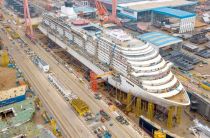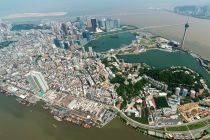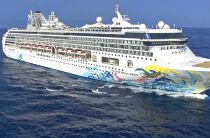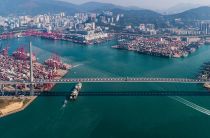Macau (China)
Cruise Port schedule, live map, terminals, news
Macau (aka Macao) is a port city and one of China's two Special Administrative Regions/SARs (together with Hong Kong) with total area approx 115 km2 / 45 mi2, of which ~82 km2 is water. The city has land area approx 33 km2 / 13 mi2) and and population around 700,000, ranking it the world's most densely populated area (20800 people per km2 / 53900 per mi2).
Macao/Portuguese Macau was established in the mid-16th-century (1557) as a trading post and a colony leased to Portugal by China during the Ming dynasty (1368-1644). Macao remained a Chinese sovereign territory (being administered by Portugal paying an annual rent) until 1887. Between 1887 and 1999, Macao was one of Portugal's overseas territories.
Portuguese Macau (the whole territory) was transferred to China in 1999, while British Hong Kong was transferred to China in 1997. China's special administrative regions/autonomous territories MSAR (Macao) and HKSAR (Hong Kong) maintain their own governments and economies (separate from those in mainland China) and even have their own flags and currencies (HKD/Hong Kong dollar, and MOP/Macanese Pataca).
The 1557-established Port Macau (locode MOMFM) is currently divided into four harbors - Interior Port (fairway/access channel max-width 55 m/180 ft, max draft 3,5 m /12 ft, houses the Inner Harbor Ferry Terminal), Exterior Port (fairway/access channel max-width 120 m/390 ft, max draft 4,5 m /16 ft, houses the Macau Ferry Terminal and Old Fishing Wharf), Taipa Ferry Terminal (adjacent to Macau Airport, both are on Taipa Island) and Kai Ho Port (on Coloane Island, houses the Container Terminal and the Oil Terminal, as well as the docking facilities of the companies Macao Cement Manufacturing and Macao Electricity).
Ferries link Macau with mainland China (Shenzhen's ports Shekou and Fuyong) and also with northern Hong Kong Island (Shun Tak Centre's Hong Kong Macau Ferry Terminal). These services are mainly via high-speed ships/catamarans operated by the companies TurboJET (Shun Tak-China Travel) and Cotai Water Jet, as well as by Yuet Tung Shipping. These fast ferries are served by the Port Macau terminals in the Outer Harbor, Inner Harbor (Yuet Tung Shipping), and Taipa.
- TurboJET is currently providing 16x daily crossings (day-time only), with the earliest departures at 7:30 am (Sheung Wan to Taipa) and the last departure at 5 pm (Taipa to Sheung Wan).
- Cotai Water Jet is currently 6x daily crossings (day-time), with the first leaving Hong Kong at 9 am and the last leaving Taipa (to Sheung Wan) at 5:30 pm.
Macau's economy is largely based on tourism and the gaming industry. In 2018, Macao's casino gambling generated USD 37+ billion, ranking it the world's largest (~7 times bigger revenue than Las Vegas'). Most casino customers are Chinese (~70%, including ~10% of the high rollers) as gaming is illegal in both mainland China and Hong Kong. Macao's casino gaming was legalized in 1962 and the current industry is run by government-licensed casinos (leased under concessions) attracting major foreign investments. Macau also manufactures and exports goods like cotton textiles, clothing, electronics, toys.
Macau Airport (at Taipa Island's eastern end) in 2019 served 9,6+ million passengers. Regularly scheduled flights by the flag carrier Air Macau link the city with mainland China (Beijing, Chengdu, Changzhou, Chongqing, Fuzhou, Guiyang, Hangzhou, Hefei, Jieyang, Nanjing, Nanning, Ningbo, Qingdao, Shanghai, Taiyuan, Tianjin, Wenzhou, Xiamen, Yiwu, Zhengzhou) as well as with Taiwan (Kaohsiung, Taipei), Thailand (Bangkok), Vietnam (Da Nang, Hanoi), Japan (Osaka, Tokyo), and Korea (Seoul-Incheon). Daily scheduled helicopter flights connect to Hong Kong and Shenzhen. The 5-busiest flight routes are between Macau and Taipei, Shanghai, Incheon-Seoul, Kaohsiung, and Beijing.
Hong Kong-Macau Bridge
The 2018-opened Hong Kong-Zhuhai-Macau Bridge (HZMB) cost CNY 127 billion (~USD 19B) and is a bridge-tunel system with total length 55 km / 34 mi. HZMB carries 6 lanes and consists of 3x cable-stayed bridges, 1x undersea tunnel/tube (length 6,7 km / 4,2 mi) and 4x artificial islands. The Main Bridge's viaduct (length 23 km / 14,2 mi) crosses the Pearl River Estuary and the three bridges allow ships to pass underneath.
As part of the HZMB project were constructed the Hong Kong Link Road (connecting the bridge-tunnel section to an artificial island) and the Zhuhai Link Road (connecting an artificial island with Gongbei and Zhuhai). The latter road also connects to three major highways - Jing-Zhu, Guang-Zhu, and Jiang-Zhu. Shuttle buses run 24 hours a day leaving every five minutes (HZMB bus travel time is ~40 min). The buses link HZMB directly to Hong Kong Port, Zhuhai Port and Macau Port.
- Cruise Industry

Adora Cruises to launch regional and international voyages from Shenzhen in Autumn 2025
Adora Cruises, a leading force in China’s maritime industry, has unveiled a detailed plan for its route deployments from Shenzhen/Shekou over...
June 12, 2025 - Accidents

Turbojet ferry suffers engine room fire accident near Macau
A turbojet ferryboat en route from Hong Kong to Macau (carrying 239 passengers plus 9 crew) suffered an engine room fire accident at ~10 AM on...
January 19, 2024 - Cruise Industry

Resorts World One kicks off high seas cruises from Hong Kong, starting March 10
Resorts World Cruises recently announced that its Resorts World One ship would commence high-seas cruises from Hong Kong, starting March 10th, 2023...
February 22, 2023 - Cruise Industry

130+ passengers arrive in Macau in first ferry from Hong Kong in 3 years
The first cruiseferry linking Hong Kong and Macau in ~ 3 years left Hong Kong Island’s Sheung Wan terminal at 7:30 am on Sunday, January 8th...
January 8, 2023 - Accidents

Ferry services suspended between Macau and Hong Kong
Ferry services between Hong Kong and Macau were suspended indefinitely in another dramatic measure aimed at limiting the spread of the deadly...
February 4, 2020 - Accidents

Ferry service from Macau to Hong Kong suspended over riots
Passenger ferry shipping services between Hong Kong Sheung Wan and Macau was closed between midnight and early Monday morning, as the Marine and...
July 22, 2019 - show more news

 63°F
63°F 
 Gentle breeze
Gentle breeze